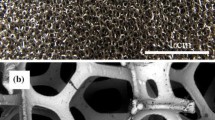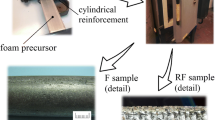Abstract
Recent studies on innovative solutions in structural engineering fields highlight the effectiveness of closed-cell aluminum foams as traditional material/architecture core replacement in sandwich structures. This study aims to investigate the mechanical behavior and the collapse modes of innovative sandwich panels with aluminum foam as the core and stainless steel wire mesh-grid as the skins; the manufacturing process was based on the powder compact melting technique. The results of quasi-static three-point bending tests point out the beneficial effects, in terms of mechanical performance, of the reinforcement skin on the sandwiches, compared to the plain foams; this joins by their effectiveness in withstanding thermal and mechanical loads. Moreover, the investigation of the collapse mechanisms of the sandwiches with different thicknesses allows for testing the goodness-of-fit of the experimentally observed collapses with the ones predicted by the failure map from analytical models available in the literature.








Similar content being viewed by others
References
Steeves CA, Fleck NA (2004) Collapse mechanisms of sandwich beams with composite faces and a foam core, loaded in three-point bending. Part I: Analytical models and minimum weight design. Int J Mech Sci 46:561–583. https://doi.org/10.1016/j.ijmecsci.2004.04.003
Liew JYR, Sohel KMA (2010) Structural performance of steel-concrete-steel sandwich composite structures. Adv Struct Eng 13:453–470. https://doi.org/10.1260/1369-4332.13.3.453
Darzi S, Karampour H, Gilbert BP, Bailleres H (2018) Numerical study on the flexural capacity of ultra-light composite timber sandwich panels. Compos Part B Eng 155:212–224. https://doi.org/10.1016/j.compositesb.2018.08.022
Kee Paik J, Thayamballi AK, Sung Kim G (1999) Strength characteristics of aluminum honeycomb sandwich panels. Thin-Walled Struct 35:205–231. https://doi.org/10.1016/S0263-8231(99)00026-9
Khan MK, Baig T, Mirza S (2012) Experimental investigation of in-plane and out-of-plane crushing of aluminum honeycomb. Mater Sci Eng A 539:135–142. https://doi.org/10.1016/j.msea.2012.01.070
Carrino L, Durante M, Franchitti S, Sorrentino L (2012) Mechanical performance analysis of hybrid metal-foam/composite samples. Int J Adv Manuf Technol 60:181–190. https://doi.org/10.1007/s00170-011-3603-0
Kahani Khabushan J, Bazzaz Bonabi S, Moghaddasi Aghbagh F, Kahani Khabushan A (2014) A study of fabricating and compressive properties of cellular Al-Si (355.0) foam using TiH2. Mater Des. https://doi.org/10.1016/j.matdes.2013.10.022
Körner C, Singer RF (2000) Processing of metal foams - challenges and opportunities. Adv Eng Mater 2:159–165. https://doi.org/10.1002/(SICI)1527-2648(200004)2:4<159::AID-ADEM159>3.0.CO;2-O
Banhart J (2018) 4.14 Production of metal foams. In: comprehensive composite materials II. Elsevier, Amsterdam, pp 347–363
Rubino F, Ammendola P, Astarita A et al (2015) An innovative method to produce metal foam using cold gas dynamic spray process assisted by fluidized bed mixing of precursors. In: Key Engineering Materials
Formisano A, Barone A, Carrino L, et al (2018) Improvement of the mechanical properties of reinforced aluminum foam samples. In: AIP Conference Proceedings. p 100007
Ashby MF (2000) Metal foams : a design guide. Butterworth-Heinemann
Banhart J, Seeliger HW (2012) Recent trends in aluminum foam sandwich technology. In: Advanced Engineering Materials, pp 1082–1087
Vaidya UK, Pillay S, Bartus S, Ulven CA, Grow DT, Mathew B (2006) Impact and post-impact vibration response of protective metal foam composite sandwich plates. Mater Sci Eng A 428:59–66. https://doi.org/10.1016/j.msea.2006.04.114
Crupi V, Montanini R (2007) Aluminium foam sandwiches collapse modes under static and dynamic three-point bending. Int J Impact Eng 34:509–521. https://doi.org/10.1016/j.ijimpeng.2005.10.001
Yang P, Shams SS, Slay A, Brokate B, Elhajjar R (2015) Evaluation of temperature effects on low velocity impact damage in composite sandwich panels with polymeric foam cores. Compos Struct 129:213–223. https://doi.org/10.1016/j.compstruct.2015.03.065
Xi H, Tang L, Yu J, Zhang X, Xie B, Liu Y, Jiang Z, Liu Z (2015) Low velocity penetration mechanical behaviors of aluminum foam sandwich plates at elevated temperature. Int J Struct Stab Dyn:15. https://doi.org/10.1142/S0219455414500631
McCormack TM, Miller R, Kesler O, Gibson LJ (2001) Failure of sandwich beams with metallic foam cores. Int J Solids Struct 38:4901–4920. https://doi.org/10.1016/S0020-7683(00)00327-9
Song YF, Xiao LR, Zhao XJ, Zhou H, Zhang W, Guo L, Wang YH (2016) Fabrication, microstructure and shear properties of Al foam sandwich. Mater Manuf Process 31:1046–1051. https://doi.org/10.1080/10426914.2015.1037900
Durante M, Formisano A, Viscusi A, Carrino L (2020) An innovative manufacturing method of aluminum foam sandwiches using a mesh-grid reinforcement as mold. Int J Adv Manuf Technol 107:3039–3048. https://doi.org/10.1007/s00170-020-05244-7
Grünewald J, Parlevliet P, Altstädt V (2017) Manufacturing of thermoplastic composite sandwich structures: a review of literature. J Thermoplast Compos Mater 30:437–464. https://doi.org/10.1177/0892705715604681
Lu X, Luo H, Yang S, Wei Y, Xu J, Yao Z (2020) Two-step foaming process combined with hot-rolling in fabrication of an aluminium foam sandwich panel. Mater Lett:265. https://doi.org/10.1016/j.matlet.2020.127427
Peng P, Wang K, Wang W, Huang L, Qiao K, Che Q, Xi X, Zhang B, Cai J (2019) High-performance aluminium foam sandwich prepared through friction stir welding. Mater Lett 236:295–298. https://doi.org/10.1016/j.matlet.2018.10.125
Viscusi A, Carrino L, Durante M, Formisano A (2020) On the bending behaviour and the failure mechanisms of grid-reinforced aluminium foam cylinders by using an experimental/numerical approach. Int J Adv Manuf Technol 106:1683–1693. https://doi.org/10.1007/s00170-019-04414-6
Hangai Y, Amagai K, Omachi K, Tsurumi N, Utsunomiya T, Yoshikawa N (2018) Forming of aluminum foam using steel mesh as die during foaming of precursor by optical heating. Opt Laser Technol 108:496–501. https://doi.org/10.1016/j.optlastec.2018.07.016
Hangai Y, Nagahiro R, Ohashi M, Amagai K, Utsunomiya T, Yoshikawa N (2019) Shaping of aluminum foam during foaming of precursor using steel mesh with various opening ratios. Metals (Basel) 9:223. https://doi.org/10.3390/met9020223
Banhart J (2006) Metal foams: production and stability. Adv Eng Mater 8:781–794. https://doi.org/10.1002/adem.200600071
Formisano A, Durante M (2017) Mechanical characterization and FEM modeling of hybrid metal foam/bio-composite samples. Int Rev Model Simul 10:13687. https://doi.org/10.15866/iremos.v10i5.13687
Mamalis AG, Spentzas KN, Manolakos DE, Ioannidis MB, Papapostolou DP (2008) Experimental investigation of the collapse modes and the main crushing characteristics of composite sandwich panels subjected to flexural loading. Int J Crashworthiness 13:349–362. https://doi.org/10.1080/13588260801933691
Vonach WK (2003) Rammerstorfer FG (2003) face layer wrinkling in sandwich shells of general configuration. Comput Fluid Solid Mech. https://doi.org/10.1016/B978-008044046-0.50179-2
Author information
Authors and Affiliations
Corresponding author
Ethics declarations
Declarations
-
No funds, grants, or other support was received.
-
The authors have no relevant financial or non-financial interests to disclose.
-
The authors have no conflicts of interest to declare that are relevant to the content of this article.
-
All authors certify that they have no affiliations with or involvement in any organization or entity with any financial interest or non-financial interest in the subject matter or materials discussed in this manuscript.
-
The authors have no financial or proprietary interests in any material discussed in this article.
Additional information
Publisher’s note
Springer Nature remains neutral with regard to jurisdictional claims in published maps and institutional affiliations.
Rights and permissions
About this article
Cite this article
Formisano, A., Durante, M., Viscusi, A. et al. Mechanical behavior and collapse mechanisms of innovative aluminum foam-based sandwich panels under three-point bending. Int J Adv Manuf Technol 112, 1631–1639 (2021). https://doi.org/10.1007/s00170-020-06564-4
Received:
Accepted:
Published:
Issue Date:
DOI: https://doi.org/10.1007/s00170-020-06564-4




